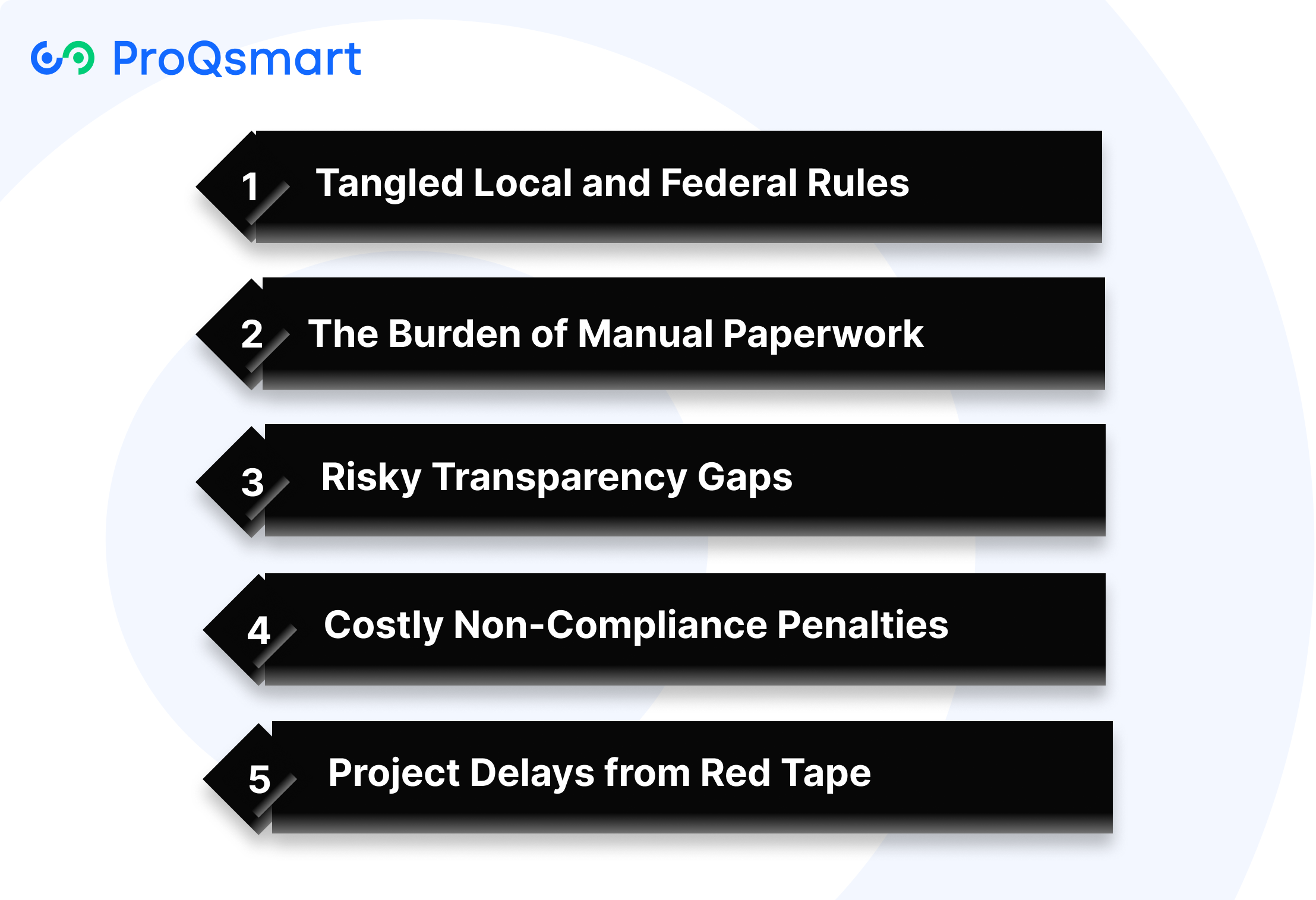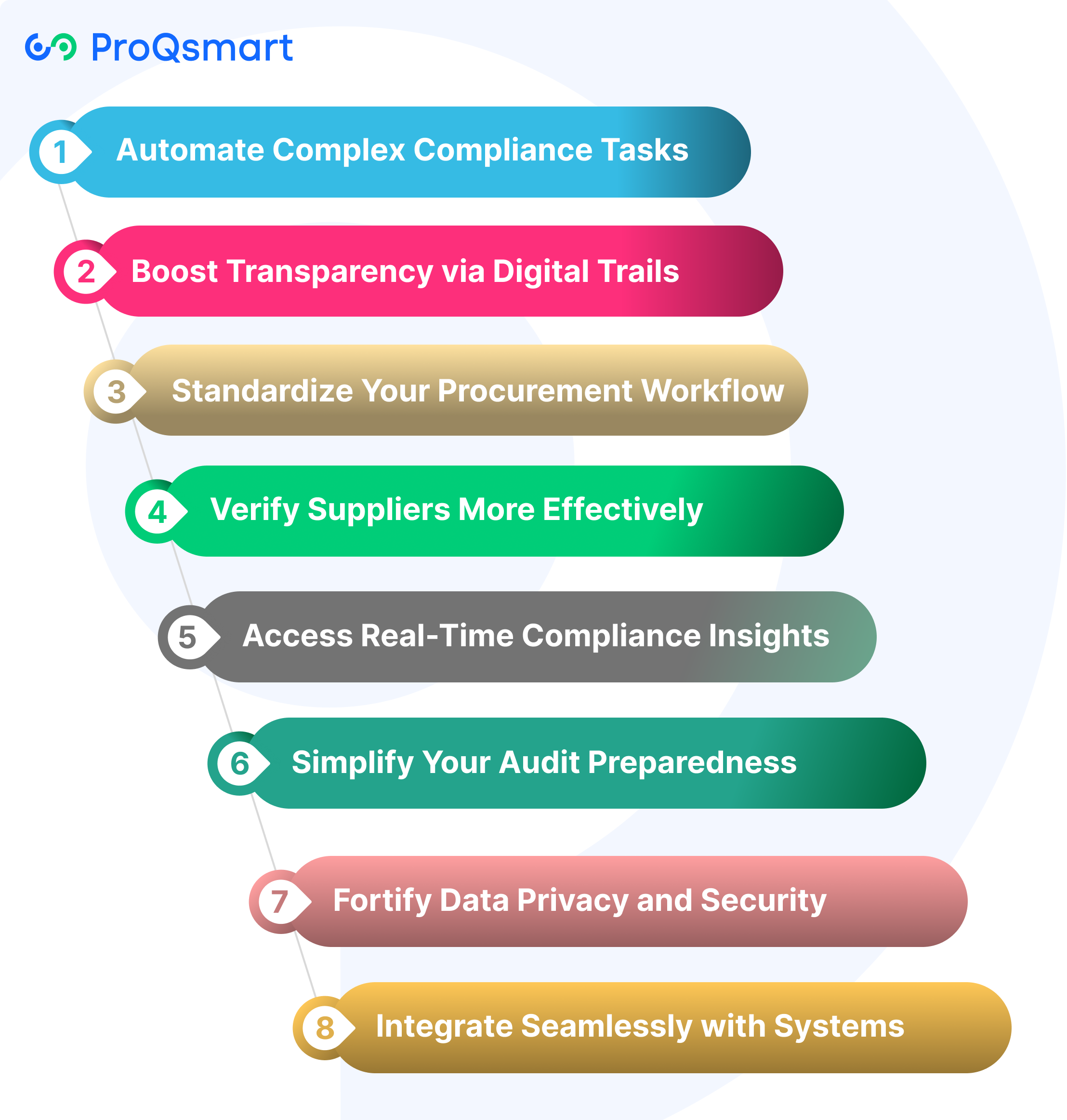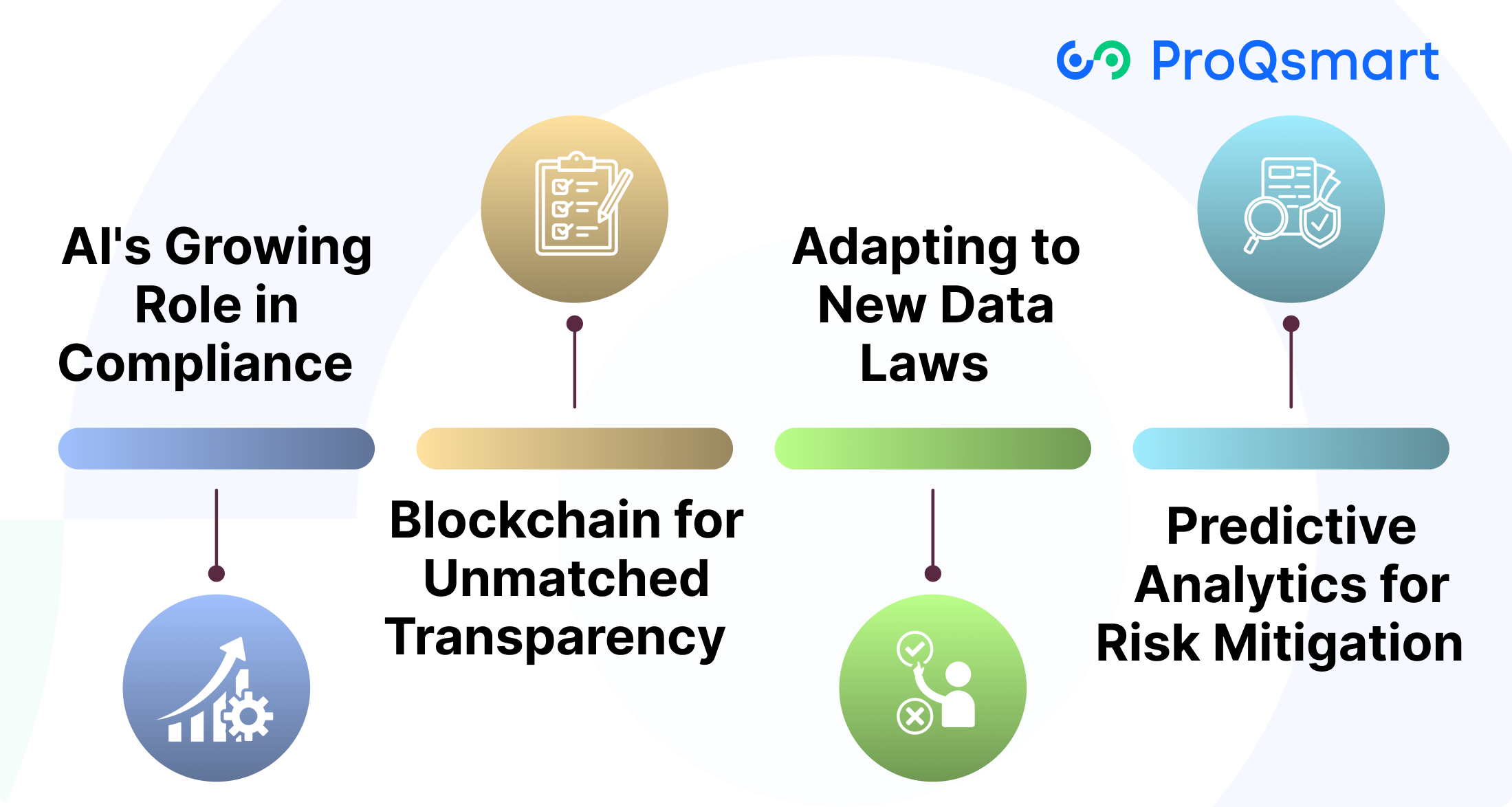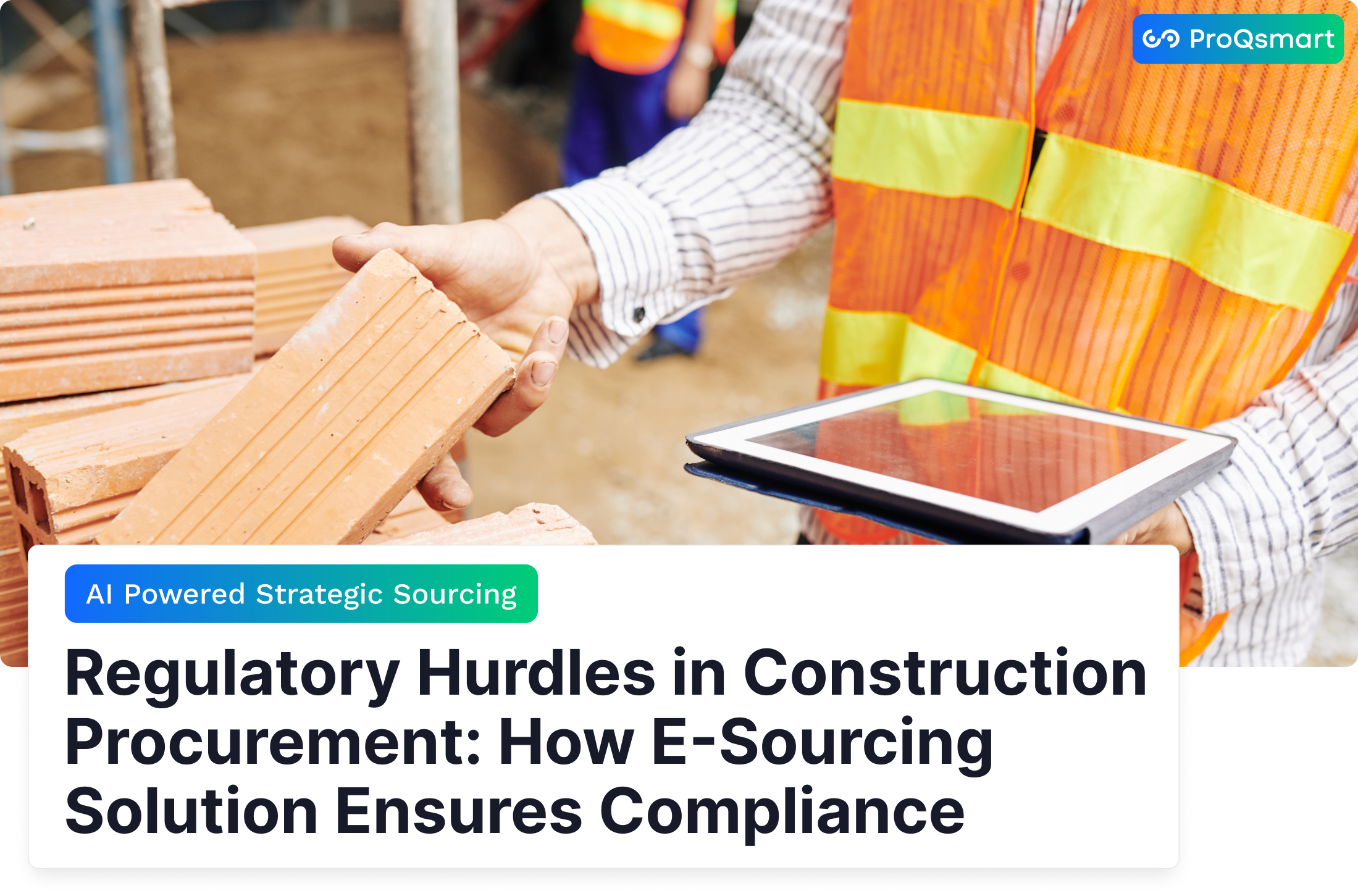Navigating regulatory requirements is one of the most persistent challenges in construction procurement. As regulations become more complex and oversight from authorities intensifies, maintaining compliance throughout the supplier selection and management process is critical. Even a minor oversight can result in costly project delays, financial penalties, or reputational risk.
E-sourcing platforms are transforming how organizations address these regulatory hurdles. By digitizing the procurement process, these solutions provide a centralized system to monitor supplier compliance, manage documentation, and track progress against regulatory deadlines. With automated reminders and real-time visibility, procurement teams can ensure that every supplier meets the necessary requirements and that all compliance-related documents are up to date.
In an era where regulatory scrutiny is only increasing, leveraging digital sourcing tools not only helps mitigate risk but also streamlines workflows and prevents unnecessary hold-ups. The following guide outlines practical steps of how e-sourcing platforms can help construction organizations stay compliant and move projects forward with confidence.
Construction’s Regulatory Roadblocks

Expensive and time-consuming construction projects still need to clear a maze of duplicative rules at both local and federal levels. From acquiring materials to the end build, regulations dictate each step. These rules can be very fluid and become increasingly convoluted. This is particularly the case in cities, where local codes can outpace national standards at breakneck speeds.
The difference between what states are required to do and what the feds require creates a double burden. Each project only gets one chance to get either requirement right. Keeping up to date requires vigilant, ongoing oversight. Once teams get behind, the potential for expensive rework or even a shutdown increases. For example, an oversight when updating local noise ordinances could delay construction for months while waiting for new permits to be issued.
Tangled Local and Federal Rules
Each area comes to the process with a unique mix of permits, safety standards, and zoning regulations. There is a need for state-local flexibility—states may require more rigorous building standards than federal agencies. For some cities, permits are reviewed in a matter of weeks—but for others, the review process drags on for months.
Contractors have to stay on top of these changes and modify plans accordingly, sometimes dealing with multiple jurisdictions at a time. A detailed compliance plan clearly identifies where each rule is applicable and where it’s not, allowing project teams to maintain their focus and resources as the regulatory landscape evolves.
The Burden of Manual Paperwork
Manual paperwork is not only a time drain, it’s prone to mistakes. Lost forms or lack of signatures can easily add weeks to the approval process. Digital platforms to manage projects allow automation of routine tasks, having all record-keeping in one place that can make audits painless.
Employing a basic checklist on every project guarantees that no key piece of documentation falls through the cracks. Automated logs allow teams to easily retrieve documentation of compliance when challenged.
Risky Transparency Gaps
Unfortunately, outdated processes continue to leave stakeholders in the dark. Without complete data, we risk masking non-compliance until it’s too late. Clear protocols, combined with software that logs every action taken, put risks front and center.
Teams can then identify potential problems in no time, maintaining good rapport with vendors and service providers.
Costly Non-Compliance Penalties
Fines for non-compliance can add up quickly, often totaling hundreds of thousands for one project. Outside of dollars, non-compliance damages reputation and may stop work in its tracks. Teams need a risk plan, regular training, and a clear list of common penalties—like stop-work orders and heavy fines—to avoid surprises.
Project Delays from Red Tape
Nationwide, permitting delays lead to significant cost overruns and lost time. Bureaucratic processes tend to lead to more approvals needed or late changes. A detailed compliance timeline helps teams manage tasks early and avoid late surprises.
Proactive dialogue with regulators and stakeholders fosters quicker approvals and more expedites continues to flow innovation.
E-Sourcing: Master Regulatory Compliance

When organizations move from paper to digital solutions, they achieve 100% visibility over all procurement activities. This kind of clarity is critical to adhering to regulatory requirements and addressing the danger posed by manual processes.
Onboarding and E-sourcing
E-sourcing automates baseline and ongoing compliance checks. Secondly, it provides procurement teams with the tools they need to monitor, audit, and demonstrate compliance every step of the way. In this section, we’ll take a look at how e-sourcing platforms are revolutionizing compliance management. They automate repeatable tasks, create transparency, and easily plug new systems into your organizational workflows.
1. Automate Complex Compliance Tasks
E-sourcing platforms can help simplify complex compliance challenges. Begin by identifying and mapping out your most time-consuming or error-prone compliance tasks. These could be tasks such as document management, supplier pre-qualification, and contract review.
E-sourcing tools, such as ProQsmart, simplify your ability to build workflows that guide users through necessary tasks. This is done through automated document compliance checks as well as real-time verification of contract compliance.
Take automated reminders — they can catch certifications or other required documents set to expire before they impact compliance status. Monitoring outcomes through integrated dashboards helps you make sure the automation is producing the desired results.
These are just a few examples of compliance-related tasks that can be automated, such as record-keeping and tracking, supplier credential validation, and producing audit-ready reports.
2. Boost Transparency via Digital Trails
E-sourcing leaves a virtual trail of breadcrumbs for each procurement activity. Every quote, contract, or supplier interaction is recorded immediately. This makes tracking who did what, and when, extremely easy.
For teams used to paper records or scattered spreadsheets, switching to e-sourcing means all documentation lives in one secure place. This format lays the groundwork for routine, straightforward audits—whether by agency staff or third party regulators.
Here’s a quick comparison:
Audits are less daunting, and accountability is increased, because digital trails don’t provide much opportunity for mistakes or arguments.
3. Standardize Your Procurement Workflow
As we all know, consistency is the bedrock of compliance. E-sourcing allows you to create and reuse templates for standard documents—RFQs, contracts, supplier onboarding forms. These templates help standardize processes by locking in required fields and required rules, preventing anyone from skipping critical steps.
By standardizing your procurement workflow, you ensure that when everyone is on the same page, errors are more readily identified and regulatory compliance is maintained. Training staff on these new workflows should accompany implementation, making sure everyone is well-versed in the system and its benefits.
A simple checklist for standardization may include: use approved templates, follow order of steps, document exceptions, and review all actions before sign-off.
4. Verify Suppliers More Effectively
Regulatory requirements frequently require extensive supplier verifications. E-sourcing addresses this by centralizing all supplier information in one location, whether it’s documentation of compliance certificates to performance scorecards.
ProQsmart, for instance, automates pre-qualification and ongoing reviews to reduce the risk of using a single, non-compliant supplier. Important factors for supplier checks are: valid certifications, financial health, past performance, and past compliance history.
E-sourcing tools can conduct these checks in an automated fashion, highlighting any discrepancies prior to entering or renewing a partnership.
5. Access Real-Time Compliance Insights
E-sourcing dashboards provide an at-a-glance view of your compliance status. Automated, real-time alerts instantly flag upcoming deadlines, expired documents, or other pending items so the entire team can stay proactive.
This enables teams to respond quicker, filling in compliance gaps before they evolve into more costly issues. Over time, you can spot trends in the data, like recurring issues with a supplier or process.
Metrics like number of suppliers in compliance, overdue corrective actions, and audit non-conformities allow teams to track performance over time and identify areas that require attention.
|
Compliance Metric |
What It Shows |
|
Compliant Supplier Count |
Suppliers meeting all requirements |
|
Overdue Tasks |
Number of past-due compliance items |
|
Audit Issues |
Findings from recent audits |
|
Document Expiry Alerts |
Certificates near expiration |
6. Simplify Your Audit Preparedness
E-sourcing turns audits into a more manageable process. All procurement files—contracts, quotes, procurement approvals—are kept in one, easy-to-locate, accessible, and searchable organized folder.
With tools such as ProQsmart, you can produce the required documents in seconds, not hours or days. Conduct periodic internal audits to ensure continued proficiency and demonstrate that compliance is an everyday practice, not a scramble at the eleventh hour.
Key items for audit readiness: updated contracts, supplier records, approval logs, and proof of due diligence.
7. Fortify Data Privacy and Security
Robust security is an absolute must in procurement. The best e-sourcing platforms are designed with layers of protection to sensitive information, incorporating encryption and access controls.
Regular staff training ensures that everyone consistently understands current privacy laws and best practices. Frequent reviews and immediate updates to security policies can address emerging threats.
Some best practices: use strong passwords, limit access to sensitive files, log all user actions, and review permissions often.
8. Integrate Seamlessly with Systems
E-sourcing is most effective when it’s integrated with your other business tools. Begin by determining which systems—such as ERP, finance, or contract management—will need to be integrated.
Create a strategy for connecting these platforms so information moves seamlessly. This prevents black holes in which important pieces of compliance information can slip through the cracks.
Integration formats could be anything from an API to file-based syncs to connectors built directly into each platform.
|
System to Integrate |
Integration Method |
Notes |
|
ERP software |
API, connector |
Syncs procurement data |
|
Finance systems |
File import, API |
Tracks spend and approvals |
|
Contract management |
Direct link/API |
Shares compliance records |
Essential E-Sourcing Compliance Features
Remaining compliant is an essential requirement for today’s procurement teams, especially in heavily regulated industries where regulations change frequently and audits are a standard practice. When compliance is a priority for e-sourcing software, it accelerates the supplier scoring process.
Beyond improving compliance, it centralizes proposal data and cuts down on manual entry. This moves teams beyond static data collection and compliance checking toward more proactive efforts on quality assurance and long-term strategic vision.
Intuitive User Interface Design
Intuitive user interface design is crucial. A clean, user-friendly dashboard is just the beginning. If the user interface is cumbersome or difficult to navigate, all the powerful compliance features in the world will never be utilized.
Compliance teams require easy navigation and straightforward prompts so that they can get to what they need quickly. Best-of-breed platforms, such as ProQsmart, constantly iterate on their interface and functionality using feedback loops.
Checklists for teams might include: clear labeling, logical workflow steps, and quick-access support.
Customizable Bid Templates
Templates need to be aligned with the regulations governing your industry. This built-in flexibility allows you to easily customize fields and requirements for each project, whether it’s RFIs, RFPs, and more.
Teams will need training on how best to modify these templates so that they accommodate special compliance requirements. Elements to include: regulatory checkboxes, supplier documentation fields, and approval sign-offs.
Robust Supplier Vetting Tools
With automated supplier checks, due diligence is faster and more efficient. Good supplier vetting tools import data and validate certifications while identifying risks.
To remain effective and ensure adherence, these tools should automatically refresh whenever rules change. Vetting steps might include: compliance history review, scorecard checks, and reference tracking.
Comprehensive Reporting Dashboards
Custom dashboards allow teams to easily spot trends and flag risks or issues. These reports need to be quick to generate and distribute.
Customization goes a long way, allowing each stakeholder group to prioritize their interests and work best. Intuitive side-by-side tool comparisons allow teams to quickly compare features, so they can select the best fit for their unique workflow.
Secure Document Management
Secure Document Management is key for compliance. Cloud-based storage, as seen in platforms such as ProQsmart, makes it easy to find files and share them while keeping them secure from unwanted access.
Teams need to receive concrete training on best practices, like maintaining version control and adjusting permission settings. Having a checklist will ensure that you don’t overlook anything.
Navigate E-Sourcing Implementation Hurdles
When launching e-sourcing in heavily regulated environments, you’re up against special barriers. It’s not uncommon for teams to get caught up in cumbersome legacy procurement systems and rigid data restrictions. New tech is intimidating—get all stakeholders on board.
Get ahead of the curve and engage the right folks at the beginning! Establish a realistic, but firm, timeline to ensure the rollout stays within the intended timeframe while addressing compliance requirements.
Tackle Legacy System Integration
Old procurement tools rarely match up with new e-sourcing platforms. Teams should start by checking how current systems and data fit with new tools. Using a phased rollout limits risk and lets staff learn as they go.
Training is key, so staff know how to use both systems together. Steps for smooth integration include: mapping data flows, testing connections, running pilots, and tracking feedback.
For example, ProQsmart’s AI platform connects legacy data, automates workflow, and brings all supplier info into one place—cutting out data silos and double work.
Empower Your Team with Training
Proper training goes a long way toward creating trust in new tools. A well-thought out program should focus on tech basics and compliance nitty-gritties—think tracking contracts and required supplier responses.
No matter how many trainings your team undertakes, it’s important to provide continual refreshers, keeping them informed as systems inevitably continue to evolve. A checklist could cover: logging in, managing e-tenders, using audit trails, tracking supplier scorecards, and spotting compliance risks.
Manage Organizational Change Smoothly
Honest, frank discussions about the benefits of e-sourcing, including reducing cycle times by up to 90%, prepare teams to adapt. A comprehensive organizational change plan solicits input at all levels and creates stakeholder buy-in.
Some strategies to accomplish this are pilot programs, open forums, and continuous updates as new features become available.
Ensure Scalability for Future Growth
Choose e-sourcing tools appropriate for today but scalable enough to accommodate future growth. Ensure the platform has customizable workflows, budget controls in real-time, and robust supplier management capabilities.
Scan these features regularly to stay abreast of business rule growth and evolution. A side-by-side option comparison table is the easiest way to show clear comparisons between options.
Future of E-Sourcing Compliance Tech

With e-sourcing compliance tech, teams have a powerful new approach to supplier selection, contract management, and regulatory hurdles. The evolution from premises-based technology to the cloud is significant. Businesses are racing to move to cloud-based technology—today, fewer than five percent of new implementations are on-premise.
Indeed, nearly three-quarters of government leaders intend to increase technology spending in 2024. More than 75% are already leveraging e-sourcing technology to facilitate efficiency. These tools reduce sourcing cycle times by as much as two-thirds, with subsequent waves achieving even greater gains.
The newly-required compliance push is also noteworthy. Advanced e-sourcing features advance compliance efforts by detecting potential risks early on before they develop into bigger issues.
AI’s Growing Role in Compliance
AI can assist teams in ensuring compliance in real-time. It identifies risks and monitors supplier information in real-time, much quicker than any human review process could!
It allows users to establish proactive alerts for emerging issues, forecast compliance gaps, and maintain a positive, uninterrupted process. AI-powered dashboards allow compliance teams to focus less time on data entry. This reduces mistakes and saves tens of hours for more strategic initiatives.
To get the most out of AI, begin by establishing automated alerts. Next, develop tailored risk models and train your personnel on dashboard functionality. ProQsmart is doing just that with AI. It allows teams to monitor supplier compliance more effectively, automate workflows, and foster deeper relationships with suppliers.
Blockchain for Unmatched Transparency
Blockchain technology can help ensure that procurement data is both transparent and secure. It allows all interested parties to view immutable records, increasing transparency, accountability, and trust.
It allows teams to track every sourcing step, view adjustments made to documents, and demonstrate compliance at each stage. In a simple side-by-side comparison, blockchain technology outperforms legacy systems on traceability and audit trails.
Adapting to New Data Laws
Keeping abreast of changing regulations is important. For folks on the ground, teams require unambiguous guidelines for new data laws, ongoing education and development, and tech that manages audits.
An effective checklist includes a policy review process, staff training, and ongoing auditing of data usage.
Predictive Analytics for Risk Mitigation
Intelligent analytics can identify emerging risk patterns, recommend preventative measures, and monitor compliance victories over time. Metrics such as supplier scorecards, incident rates, and audit findings allow teams to identify emerging issues before they become crises.
This proactive approach ensures that sourcing can continue without interruption.
Conclusion
E-sourcing solutions have redefined how construction organizations approach regulatory compliance. By automating document management, providing real-time risk alerts, and centralizing all compliance activities, these platforms eliminate uncertainty and streamline even the most complex regulatory processes. Instead of chasing paperwork or worrying about missed requirements, procurement teams can rely on intelligent systems to flag issues, ensure timely submissions, and maintain audit-ready records at all times.
This shift not only reduces operational stress but also turns compliance into a strategic advantage-enabling organizations to focus on project delivery and business growth rather than regulatory hurdles. For those seeking a more efficient, reliable, and transparent approach to procurement compliance,
Ready to experience the benefits firsthand? Book your demo with ProQsmart today.




